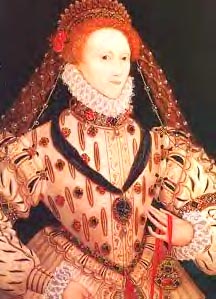

Queen Elizabeth I
Written and researched by Margaret Odrowaz-Sypniewska
 .....
.....
Queen Elizabeth I (r. 1558-1603)/Elizabeth Tudor (1533-1603) was born on September 7, 1533 at Greenwich Palace, London, England. Her mother, Anne Boleyn, was beheaded for adultery when Elizabeth was three. Elizabeth was brought up at Hatfield House in Hertfordshire, England. She was well-educated and an intellect. Elizabeth escaped the congenital syphilis passed on by Henry VIII to his other children, and Elizabeth was a strong and healthy child. She knew Latin and French and was taught Italian by Castiglione. Elizabeth was declared illegitimate when Henry VIII married Jane Seymour. However, she came to the throne in 1558 after the short reigns and deaths of Edward VI (age 16), Lady Jane Grey (age 17), and Mary I (aged 43). Mary, her half sister by Catharine of Aragon, had Elizabeth locked up in the Tower of London, because Mary was a Catholic and Elizabeth was
Anglican.
In 1586, Elizabeth survived the Babington Plot to assassinate her and put Mary, Queen of Scots on the throne. Mary was the daughter of James V of Scotland and Catholic. Elizabeth responded by repressing Catholicism and executed Mary.
During Elizabeth's reign the Spanish Armada was defeated (in 1588).
Even though she was never married, Elizabeth had a few men who wanted her hand and attentions. Sir Thomas Seymour, brother to Henry's third wife, Jane Seymour, tried to interest her when she was a teenager. She denied his advances. Henry of Navarre once kissed her on the lips in front of witnesses. Phillip II of Spain also fancied himself as a possible groom.
Her court favorites included:
Robert Dudley, Earl of Leicester ("Sweet Robin"), who was her first love. However, his wife died of suspicious causes, Guilford Dudley, husband of Lady Jane Grey was brother to Robert Dudley. After Robert's wife Amy Robsart's death in 1560, Elizabeth could not trust him and their liaison ended, even though he pursued her for 20 years. Dudley died in 1588.
Another favorite was Francis Duc de'Alecon ("Petite Grenouille"). He was not a handsome man, but had smallpox scars, a double nose, and had "dwarfish" features.
Robert Devereux, 2nd Duke of Essex defeated the Spanish at Cadiz, and Elizabeth gave him a ring to be used as a ticket out of trouble if he ever ran afoul of her. In 1601, Elizabeth signed his death warrant for "insurrection." Robert sent the ring, but an enemy stopped its delivery and he was executed. Elizabeth was said to have wept for days, and afterwards at the mere mention of his name. Robert Devereux, the Earl of Essex was the last person to be beheaded in the Tower of London. Robert was the rival of Sir Walter Ralegh. Devereax was a hero after he laid seige to Cadiz in 1596. He was a very popular figure in Elizabeth's court.
Elizabeth had a near-death experience when she contracted smallpox in October 1562. After this she had scars which she tried to cover up with white lead make-up. This most likely shorted her life and caused her hair to fall out. Her beauty ruined, Elizabeth never thought of marriage or men much again.
Elizabeth also favored Sir Christopher Hatton, the captain of her bodyguards, for she owed her life to him and he was a loyal protector.
Elizabeth had no legitimate issue but was rumored to be the mother of Arthur Dudley, Robert Dudley, earl of Leicester's son. However, how she would have hid the pregnancy was a mystery. And why would she give up her own son? Thus without proof it was but a rumor. Another royal suitor was Henri. duke of Anjou, however she avoided him on religious grounds and most likely because he was a bisexual and a transvestite. Henri's younger brother, Francois, duke of Alencon stepped up to take his place. Elizabeth nicknamed him "frog," because of his youth and in 1581 she announced that she would marry him. He died in 1584. Rumor was that she picked him as husband-to-be because she needed to throw off her advisors who wished her to wed. Picking a sickly young man who was yet of age, made it possible to satisfy their prompting without having to carry out the act, thus silencing them for a time. Elizabeth might have been a true virgin, and she many times stated that her own virginity was her strength.
Elizabeth had reddish-gold hair, hazel eyes, and a slightly hooked nose. Her looks were marred by her black teeth (from eating too much sugar). She spent lots of money on her clothes and passed a law forbidding commoners from wearing her now famous ruffs.
Elizabeth I died at Richmond Palace on March 24, 1603 (at age 69). She had no will, but made it clear that she wished to have her cousin, James VI, as her successor. Elizabeth was a popular ruler and the "Elizabethan Age" was the golden age of England. Rumor has it that her last days were rememberances of Robert Dudley, and many thought perhaps they would reunite in heaven, providing Robert made it there (he
was suspicioned to have killed his wife).
Facts About Elizabeth I
See Bibliography regarding Elizabeth I and white lead under Strange History.
MORE ON ELIZABETH I:
Elizabeth I This page has a wealth of information.
